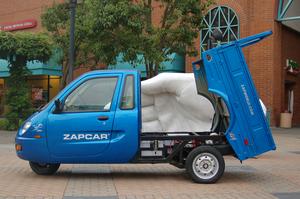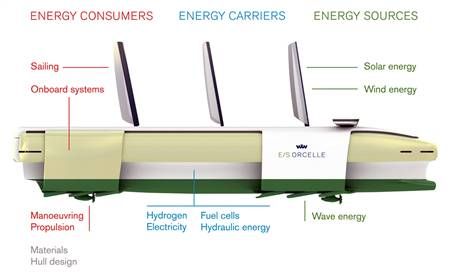
Example of a solar tree grove in a parking lot.
Below are some examples of money their saving by doing different things like using renewable energy or using fluorescent bulbs.
Solar and Other Renewable Energy Sources
Cost-effective application of solar and other renewable energy sources is an important priority for DoD. The "Million Solar Roofs Initiative" is a commitment to use renewable solar energy wherever it makes sound economic sense. DoD’s plans include using over 3,000 solar applications on buildings by FY00, and 1,000 applications of photovoltaic technology on non-building systems.
Moanalua Terrace at Pearl Harbor, Hawaii, installed solar hot water heaters in 136 units of military family housing, and plans to install them in 516 additional units. DoD also installed photovoltaic applications at many test and training ranges in remote locations where utility power was not available. These were previously powered by diesel generators, costing as much as $2.00 per kWh. Photovoltaic power, by comparison, costs from $0.25 to $0.35 per kWh.
Eliminating the Use of Ozone Depleting Substances
Robins Air Force Base, Georgia, reduced ODS emissions by 99 percent and chemicals on EPA’s list of the 17 most hazardous chemicals by 89 percent from the 1992 baseline. The installation virtually eliminated methylene chloride use in paint stripping operations, resulting in annual savings of $790,000 for C-141 aircraft alone. Robins also implemented an ultraviolet light disinfection system at the sewage treatment plant, eliminating the use of 8,000 pounds of chlorine annually.
The Navy’s China Lake Energy Office, California, installed three unique photovoltaic projects on Santa Cruz Island, 8.5 miles from the mountaintop facility. These projects include a photovoltaic array that provides 139 kilowatts to a battery bank capable of holding 2.4 million watt hours. Another project is a water pump, powered by energy from the photovoltaic application, which provides water from 1,500 feet below the surface to the installation. In the initial year of the projects, the Navy saved $400,000 and expects to continue saving.
Improving Energy Efficiency at DoD Facilities
Fort Hood, Texas, is the U.S. Army’s premier installation for training and deploying heavy forces and has made great strides toward improving energy efficiency. Fort Hood’s Pollution Prevention Program is designed to improve cost savings and decrease emissions by preventing generation of solid waste, wastewater, and air emissions through source reduction, reuse, and recycling.
Fort Hood installed a parking lot solar lighting and an active daylighting system. The active daylighting system virtually eliminates all daytime electric lighting, equaling more than 1.4 billion Btus of renewable energy. In the future, each unit is expected to generate power equivalent to 600 to 800 fluorescent light bulbs, saving almost $20,000 each year. Just two panels of the parking lot solar lighting system produce 800 kilowatt hours (kWhs) per year, eliminating more than one ton of emissions. Combined, the two projects have saved approximately 2.5 billion Btus and $103,000. Fort Hood also installed vapor recovery systems on fuel tanks.
This document was from when Ale Gore was vice president as far as I know some things have changed. The main thing being the cancelation of the hybrid hummer program. Besides that as far as I know they have kept on schedule with the program. In fact because of the war in Iraq, the military is realizing even more so the economic sense of using renewable energy and developing alternative powered vehicles. One can only hope that this will catch on in the Air Force and Navy more. Another interesting possibility would be solar trees for military installations with huge parking lots. Solar tree's are basically solar panels that are supported by structures that also can serve to provide shade for vehicles. Right now the military is doing great at conserving power and using renewable energy at its facilites, the next step is for them to start working on making their ships, vehicles and aircraft more efficient. I'm starting to email our senators in the senate armed services committee.
Here is the list with links to their websites were you can then contact them on what issues you want.








